Understanding HOTBIN Compost: A Visual and Sensory Guide
Composting is an essential practice for any gardening enthusiast, and understanding the characteristics of good compost is crucial. In this guide, we dive into the world of HOTBIN compost, to explore its unique qualities and benefits.
The Surprising Appearance of HOTBIN Compost
First things first, HOTBIN compost may not look like what you expect. When you first harvest your compost, be it during Spring, Summer or in the Autumn, don't be fooled by its appearance! Although it might seem sticky, moist, and even lumpy, this doesn't indicate poor quality. In fact, it's quite the opposite. These attributes are a good sign that your HOTBIN compost is rich in humic substances, vital for enhancing your soil's water and nutrient retention capabilities.
How Does HOTBIN Compost Compare Visually?
Visual Inspection - Below are 6 samples of compost
| Pic 1 - Vermicompost | Pic 2 - Garden Centre Compost | Pic 3 - Traditional Cold Compost |
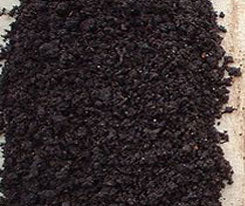 |
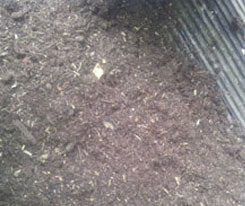 |
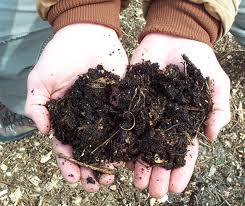 |
| Looks fine and rich | Looks fine and free flowing, uniform and has probably been sieved | Looks mature, maybe 2 years old and as expected |
| Pic 4 - HOTBIN Compost at 3 months | Pic 5 - HOTBIN Compost too wet | Pic 6 - Anaerobic compost |
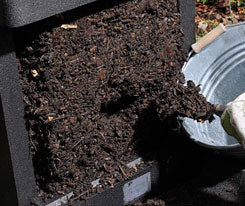 |
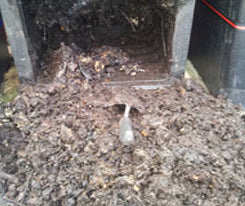 |
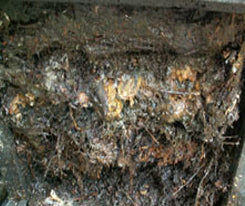 |
| Looks great; dark, rich, sticky and crumbly | Looks water logged, lumpy, immature and soggy | Definitely looks anaerobic, it’s black sludge not compost |
For those wanting the science behind the look and feel of compost, our analysis will include the following:
- Carbon / nitrogen maturity test
- Visual after drying and sieving
- Pliability / colloidal behaviour
- Humus test
- Result to quality – Is it great compost?
1. Compost: Carbon/Nitrogen Maturity Test
Industrial producers of compost (i.e. those behind the compost being sold at your local garden centre) do a check to establish how active the bacteria are. Above a certain level and the compost is too active (i.e. not mature & stable) it needs to be left longer otherwise it can draw nitrogen from the soil as bacteria continue to use the carbon in the remaining compost.
The maturity and stability test can be undertaken via the Solvita compost test method. You can do these tests at home, although it can get expensive!
Garden centre compost (Pic2) would not have gone on sale without passing the C/N maturity and stability tests.
How did HOTBIN (Pic4&5) compare? Well they both fall in the stable and mature range. This will surprise a lot of experts as they look lumpy and lumpy normally means large pieces of non-composted material which is highly likely to result in an ‘active’ rather than stable result.
2. Compost Sieving Test: Revealing Fine Qualities
If you prefer finer compost particles, simply drying and sieving HOTBIN compost can yield a surprisingly high amount of fine material. When dried and sieved, about 80% of HOTBIN compost passes through a fine 8mm mesh.
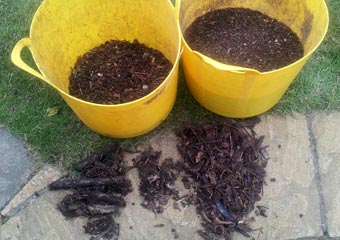
Visually comparing the sieved HOTBIN compost with the sieved garden centre compost they now look very similar.
What didn't go through the sieve was made up of about 15% of wood chip pieces (8-15mm) and 5% oversize non-composted items (notably pampus grass roots – these are possibly going to take the record for the hardest most difficult material to compost).
This sieve result is not a one off – we have seen it many times with the same results.
3. Compost: Pliability and Colloidal Behaviour
When we sieve and handle HOTBIN compost we notice something else – it is very sticky. It rolls into balls in the sieves and when you grab a handful you can make a ball. It is ‘pliable’ just like a potter’s clay or children’s plasticine.
There are two common substances in soils and composts that create a pliable mix – clay and humic compounds. Both of these are examples of ‘colloidal’ materials and it is this property and the resultant way they hold water that leads to the pliability.
We can take the pliability test a little further. If we make a ball of moist compost from Garden centre compost and HOTBIN compost (Fig5) and leave then to dry in the sun for 4 days. Now what happens when we try and squeeze each ball?
|
HOTBIN Vs Garden Centre Compost compost pliability |
HOTBIN Vs Garden Centre compost pliability after drying |
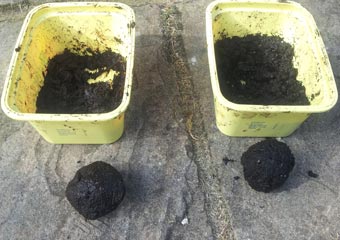 |
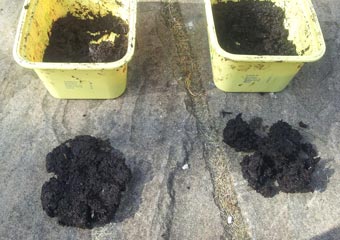 |
The garden centre compost sample behaves more like peat – it sticks when wet, dries fast (i.e. it looses water 2-4 times faster) and then the organic material falls apart when the dry ball is pressed.
In contrast, the HOTBIN sample is still damp and pliable. It forms a very hard solid outer layer of material with a soft inner. Even after drying and re-wetting the compost sample, the same level of pliability returns.
Please note that the HOTBIN compost (and certainly the batch of HOTBIN compost above) had no soil added. As a result, the pliability of the above compost is not believed to be due to soil clay.
4. Compost: The Role of Humic Substances
We believe (and we mean ‘believe’ because we have no laboratory proof) that it is possible that HOTBIN compost has more humic substances than many other composts.
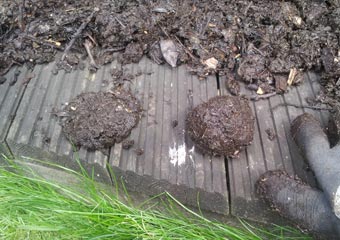
Can we test for humic substances?
The answer is yes but not easily outside a fully operational soil testing lab. There is a relatively simple humus soil test – targeted at measuring the concentration of humic substances in soils.
The HOTBIN samples are off the scale – but a note of caution – the test aims to give a reliable field test for soils with 0.5-6% humic substances. It cannot be relied on for concentrations well above this.
5. Is HOTBIN Compost, Great Compost?
We believe that the high humic substance content in HOTBIN compost sets it apart from ordinary composts. By adding this to your soil, you're enriching it with components that improve soil health more effectively.
Partially decomposed material (compost) will continue to decompose once it has been added to the soil and when the carbon cycle eventually complete, the material is returned to carbon dioxide whilst a small residual amount of humus remains in the soil. Humic substances do not decompose in the soil (to any great extent) so adding a concentrated form will improve your soil faster.





